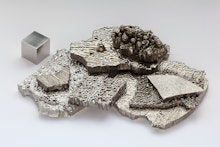One Element Could Unlock the Future of Sustainable Energy

Cobalt, everyone's favorite blue magnetic chemical element, can now help save the world.
As described in a study in the journal Nature, a team of scientists developed a microscopically thin material made of cobalt to convert carbon dioxide gas into a clean-burning fuel called formate. Essentially, they're taking the same stuff that causes a 60-degree day in January and turning it into an energy source.
What's more, that material, made of cobalt metal and cobalt-oxygen molecules, is only four atoms thick. For scale, a typical atom's radius is one tenth of a billionth of a meter.
The team, led by Shan Gao from the Hefei National Laboratory for Physical Sciences in Hefei, China, used a process called electroreduction to move a small electric current through the superthin cobalt material, changing the carbon dioxide's makeup and producing the new clean energy source.
With a pulse of electricity, a hydrogen atom attaches to the CO2's carbon molecule, and an electron is added to the carbon dioxide. So now you have carbon, hydrogen and two oxygen molecules: CHOO, the compound for formate.
"This represents a fundamental scientific breakthrough," said Karthish Manthiram, a chemical engineer at the California Institute of Technology, according to Popular Mechanics. Manthiram studies CO2 electroreduction but didn't have a hand in the new technology. "Certainly it will be a yearslong process before this is worked into a successful, commercial device. But at this stage of development, by all conceivable metrics, this reaction looks very positive."
We probably won't see a four-atom-thick global air filter going to market any time soon. But Gao, the paper's lead author, said his team has a way to rapidly produce the formate.
Here's where it gets exciting: If produced for large application, Gao's material could stretch to turning regular power plants, ones that contribute to the production of 36 gigatonnes of CO2 annually, into what you might call double or second-hand power plants: After the first stage of power production is complete, the new material would then turn the CO2 byproduct into a completely separate fuel source.
Power plants pulling double-duty, fueled by a gorgeous metal element. That's a solution to our climate crisis worth getting excited about.